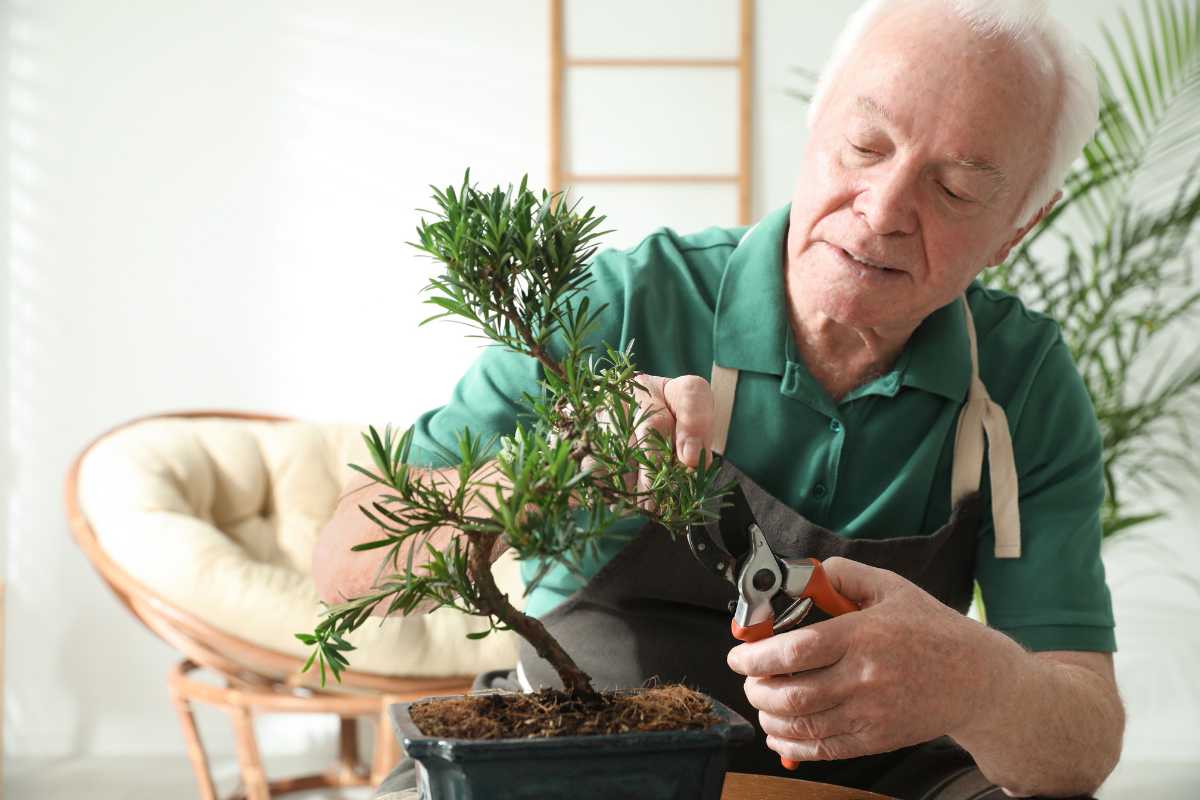How long can a bonsai tree live? Many bonsai enthusiasts ask that question, but there is no straightforward answer.
A bonsai tree can live up to 1000 years or even longer with proper care and maintenance. If you fail, a bonsai tree can die in as little as 2-3 months. In addition to soil, fertilization, humidity, pruning, and other factors, a bonsai’s lifespan varies by bonsai species. For example, the Japanese maple can live up to 80 years, while the Chinese elm can live up to 50 years.
Continue reading to get more in-depth into how long bonsai trees live and the factors that affect how long they can live.
- Related article: Tips for Growing Bonsais
4 Key Takeaways on How Long Can a Bonsai Tree Live
- Bonsai trees can live for several hundred years, with some species like Ficus bonsai living over 1,000 years.
- The lifespan of a bonsai depends on factors like species, care, and environment, with Ficus and Juniper trees living longer than Maples or Azaleas.
- Outdoor bonsai typically live longer than indoor bonsai due to better growing conditions.
- Bonsai trees require constant attention and thrive in controlled environments, which can significantly increase their lifespan.
How Long Do Bonsai Trees Live?
Bonsais can live for several hundred years but are usually pruned or replaced after they reach a certain age. Some trees grow slowly, while others grow more quickly.
Bonsais normally take anywhere from 5 to 15 years to reach maturity. Bonsai trees grown indoors are the exceptions. They can be transplanted outdoors in as little as 3 years.
- Read more: How Long Does It Take for a Bonsai Tree to Grow?
Bonsais require constant care and attention and they must be kept in the perfect growing conditions. Plenty of nutrients and a pest and disease-free environment are key to keeping a bonsai tree healthy.
Don’t be fooled by the small size either. Their small size doesn’t mean they have shorter lifespans.
Here are the key points about the bonsai lifespan:
- Controlled Environment – Unlike wild trees that face threats from storms or diseases, bonsai trees are protected in a controlled environment, allowing them to live much longer.
- Extended Lifespan – With proper care, bonsai trees can outlive many other plants, often becoming cherished heirlooms. Some specimens, like a Ficus bonsai in Italy, are estimated to be over 1,000 years old.
Factors That Affect How Long Bonsais Live
Bonsai trees need the right amount of care to grow properly. If you aren’t giving them the right growing conditions, they won’t live very long (hundreds of years).
Types of Bonsai Trees

The species or the type of bonsai tree has a major impact on its potential lifespan. Some species naturally live longer than others. Examples of bonsai trees that can have longer and shorter lifespans are:
- Azaleas and Cherries have shorter lifespans of around 50 years on average
- Ficus and Juniper species can live for hundreds of years with proper care
- Maples and Elms typically live for several decades to a century
Learn about some of the popular types of bonsais.
Care and Maintenance
The level of care and maintenance provided to a bonsai tree is critical for maximizing its lifespan. Key factors include:
- Proper watering – avoiding both over and underwatering
- Adequate sunlight – providing the right amount for the species
- Appropriate fertilization – supplying essential nutrients
- Timely pruning and wiring – to maintain desired shape and health
- Repotting at the right intervals – to prevent root binding
- Vigilance against pests and diseases – disease and pest prevention measures are important
Environment
The environment plays a big role in how long your bonsai tree lives. Here are the main factors to pay attention to:
- Temperature – Each bonsai tree type has its own temperature needs. If it’s too hot or too cold, the tree gets stressed, which can shorten its life.
- Humidity Levels – This is super important, especially for tropical bonsai. Not enough humidity dries them out, but too much can lead to diseases.
- Air Quality – Bonsai needs clean air to stay healthy. If the air is polluted, it can cause health problems that affect how long they live.
- Light Exposure – Different bonsai types need different amounts of sunlight. Not enough light makes them grow slowly and weakens them. Too much direct sunlight can burn their leaves.
- Soil Composition – Good, well-draining soil is important. Bad soil can cause root rot or make them lack nutrients, both of which shorten their lifespan.
- Protection from Elements – Bonsai trees are usually kept safe from storms and pests. This protection helps them live longer if you take good care of them.
By making sure your bonsai tree has the right environment, you can help it live a long, healthy life.
Pruning and Trimming Bonsais for Optimal Health

Bonsais need to be pruned regularly to help them grow. Deciduous bonsai trees respond better to scissors, while conifers can thrive with either finger pruning or scissors.
Here are some key points on how bonsai trimming can help optimize the lifespan of your bonsai tree:
Why Is It Important to Prune Bonsais?
To keep your bonsai tree small, shaped right, and healthy for a long time, you need to trim it regularly. This act of trimming, known as regular pruning, is key. It helps your bonsai grow new leaves and stops it from getting too big.
When you cut branches, it’s important to protect your tree from bugs and sickness. You can use special sealants for this. For example, if you have a conifer bonsai, you can use wax sealant. For other types of bonsai, like those with broad leaves, tar-based paint works well.
This careful maintenance ensures your bonsai stays in great shape and lives a long, healthy life.
Different Ways to Prune Bonsais
There are two main types of pruning you should know about:
- Maintenance Pruning – You do this to keep your bonsai small and help it grow new leaves. The best time for this is in spring and summer when the tree is growing a lot.
- Structural Pruning – This is a more serious cut to shape your bonsai. It’s best to do this in fall and winter when the tree is resting. This way, the tree gets less hurt.
Knowing when and how to prune helps your bonsai stay strong and beautiful.
Pruning Timing and Frequency
Pruning your bonsai the right way is key to helping it thrive for generations. Here’s how you can do that:
- Prune your bonsai tree every year. This keeps it from getting stressed out.
- Don’t take off too much at once. It’s best to remove just a little bit, about one-third to one-half of the leaves, each time.
Following these pruning tips for your bonsai tree can make a big difference. It’s a key part of caring for your tree and helps with its life expectancy. Remember, proper trimming helps your bonsai stay healthy and look good for a long time.
Bonsai Tree Pests, Diseases, and Treatments
Bonsai trees are susceptible to various pests and diseases that can significantly affect their health and lifespan. Here are the key details regarding these threats:
Common Bonsai Pests
- Aphids – Small, pear-shaped insects that suck sap from leaves and stems. They can cause leaf curling and stunted growth. Aphids also excrete honeydew, which can lead to sooty mold.
- Spider Mites – Tiny red or brown mites that thrive in dry conditions. They spin webs on leaves and can cause yellowing and leaf drop.
- Scale Insects – Oval-shaped pests that attach to leaves and stems, leading to yellowing leaves and stunted growth. They can be removed manually or treated with insecticidal soap.
Common Bonsai Diseases
- Root Rot – A fungal disease caused by overwatering or poorly drained soil, leading to brown, mushy roots and an overall decline in health.
- Powdery Mildew – A fungal infection that appears as a white, powdery coating on leaves and stems, often due to high humidity and poor air circulation.
- Black Spot – A fungal disease that manifests as black spots on leaves, leading to yellowing and eventual leaf drop.
- Leaf Spot – A bacterial or fungal infection characterized by dark spots on leaves, which can weaken the tree and lead to leaf drop.
Prevention and Treatment
- Sanitation – Sterilize tools after pruning infected trees and remove any affected leaves or branches to prevent the spread of disease.
- Regular Inspection – Monitor bonsai trees for signs of pests or diseases, allowing for early detection and treatment.
- Proper Care – Maintain optimal watering, fertilization, and environmental conditions to keep the tree healthy and resilient against pests and diseases.
- Insecticides and Fungicides – Use appropriate treatments for identified pests and diseases, following the manufacturer’s instructions to avoid harming the tree.
Bonsai Tree Lifespan Final Thoughts

Bonsai trees stand out because they can live for many years, even hundreds, if you take good care of them. How long they live depends on things like the type of tree, where you keep it, and how well you look after it.
Taking care of a bonsai tree means regular attention, but the reward is a lasting bond with nature. When you learn what your bonsai needs and give it a good home, you help it grow strong. This care can turn your bonsai into a cherished part of your family for years to come.
Bonsai Tree Lifespan FAQs
1. How Long Do Indoor Bonsai Trees Live?
With the right care, indoor bonsai trees often live between 50 and 80 years. It’s not uncommon for some to live over 100 years if conditions are just right. This longevity shows how dedicated care can lead to a long life for these beautiful trees.
2. Are Bonsai Trees Hard to Keep Alive?
Bonsai trees can be challenging to keep alive, but with proper care and attention, they can thrive for many years.
3. What Is the Oldest Living Bonsai Tree?
The oldest living bonsai tree is a Ficus retusa linn, also called a Ficus Bonsai. It’s in the Crespi Bonsai Museum in Milan, Italy, and it’s over 1,000 years old.
Learn more about bonsais with the help of these articles:



